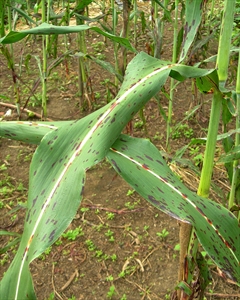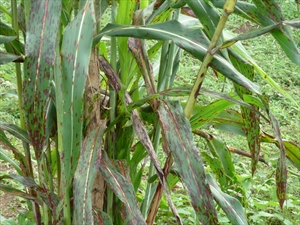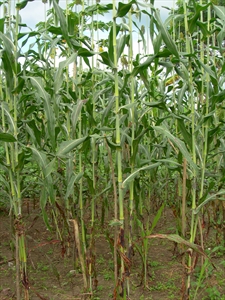Sorghum streaky spot, bacterial leaf streak
Pacific Pests, Pathogens, Weeds & Pesticides - Online edition
Pacific Pests, Pathogens, Weeds & Pesticides
Sorghum streaky spot (073)
Xanthomonas vasicola pv. holcicola; previously, Xanthomonas campestris pv. holcicola. Note, identification of this pathogen requires confirmation. Symptoms of Drechslera sorghicola (target leaf spot) are similar. Both pathogens have been recorded from Solomon Islands (see check list by Eric McKenzie and Grahame Jackson).
Asia, Africa, North and South America, Europe, Oceania. It is recorded from Australia, New Zealand, and Solomon Islands.
Sorghum, millet, and maize (a minor host). The weed, Johnson grass, Sorghum halepense, is also a host.
Narrow, reddish-brown, 2-3 mm wide, 5-15 mm long, somewhat rectangular, streaks appear on the lower leaves (Photos 1&2). During wet weather, these merge to form long irregular streaks and blotches throughout all or much of the leaf (Photo 3). The leaves die and hang down around the stem (Photo 4). Large, irregular reddish-brown to black blotches also develop on the leaf bases and stems.
The disease is unlikely to be seedborne from studies done in other countries. Spread of the disease is likely to be from crop debris in the soil, and from wild grasses. Johnson grass (Sorghum halepense ), is present on the Guadalcanal Plains and presumably is an alternative host for this bacterium. The bacteria ooze from the spots during wet weather, and are spread in wind and rain. Survival is also on crop debris and wild grasses.
The spots and streaks merge to form large dead areas on the leaves, usually beginning on the lower older leaves, and progressing upwards. However, the impact of the disease in Solomon Islands is unknown, but it seems that the variety used for livestock feed matures before major damage is done, and yields are, perhaps, little affected.
Look for the reddish-brown, rectangular spots on the leaves that spread rapidly and join together, causing a blight, especially in wet weather. Identification of the bacterium requires isolation in the lab, and expert examination of the bacterial colonies using chemical tests.
CULTURAL CONTROL
Before planting:
- Do not plant sorghum on the same land two crops in succession.
- Although the bacterium has not been proven to be seedborne, it is important to use 'clean' seed, i.e., seed from crops that were free from the disease before the seed was taken.
After harvest:
- Destroy all the leaves and stems by burning.
- Do not leave the trash to rot in the field, especially if another crop is to be planted on land nearby.
RESISTANT VARIETIES
There is no information on varietal resistance of sorghum to this disease in Solomon Islands, and little elsewhere. Testing different varieties would be worthwhile.
CHEMICAL CONTROL
Chemical control is not appropriate for this disease, especially as sorghum is not grown commercially in Solomon Islands; it is grown for village poultry where use of chemicals would be uneconomic, and hazardous to the poultry as well as to those who eat them.
AUTHORS Helen Tsatsia & Grahame Jackson
Information from CABI (2015) Xanthomonas vasicola pv. holcicola (streaky spot of sorghum and Sudan grass). Crop Protection Compendium. (https://www.cabi.org/cpc/datasheet/56942); and from McKenzie E, Jackson G (1986) The fungi, bacteria and pathogen algae of Solomon Islands. Strengthening Plant Protection and Root Crops Development in the South Pacific. Field Document 11. Food and Agricultural Organization of the United Nations in Association with the South Pacific Commission.
Produced with support from the Australian Centre for International Agricultural Research under project PC/2010/090: Strengthening integrated crop management research in the Pacific Islands in support of sustainable intensification of high-value crop production, implemented by the University of Queensland and the Secretariat of the Pacific Community.







